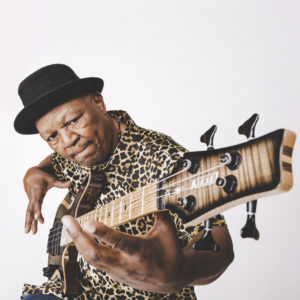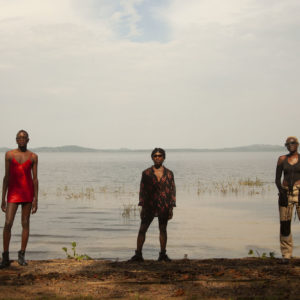Lee ‘Scratch’ Perry’s final experiment
The last album on which the dub pioneer features is a collaboration with New Age Doom. It’s genre-defying and a fitting end to a spirited musical career that spanned six decades.
Author:
29 December 2021

Life is an experiment
The more you experiment
You make the world better
For each other
These words from Lee “Scratch” Perry appear two minutes into Life Is an Experiment, the opening song on the dub pioneer’s collaborative swansong, Lee “Scratch” Perry’s Guide To the Universe, released posthumously in early November.
The album, a collaboration with Canadian duo New Age Doom, draws on dub, noise, psychedelia, heavy metal and free jazz while Perry delivers words of wisdom.
When you consider that his spirit of experimentation resulted in many technical innovations that have influenced music over his six-decade career, “life is an experiment” feels like a fitting philosophy. Perry left a rich legacy of production wizardry for future generations to expand on when he died in August at the age of 85.
While his career began in the late 1950s under the watchful eye of producer Clement Coxsone Dodd, Perry was still cranking out top-notch albums as recently as 2019. Rainford and Heavy Rain were both produced by longtime collaborator Adrian Sherwood.
Outside the box
New Age Doom emerged with their debut, self-titled album in 2019. But it was their second album, Himalayan Dream Techno on Toronto label We Are Busy Bodies in 2020, that earned the band rave reviews. Their ambient drone metal has been compared to musical luminaries Miles Davis, Frank Zappa, Sun Ra, Black Sabbath and Pink Floyd.
Critics scrambled to define the band’s sound by placing it in boxes such as post-rock, psych-rock or new-age drone. None seemed a good fit. The band’s sound was turning out to be unclassifiable.
In August 2020, four months before New Age Doom released Himalayan Dream Techno, Perry was doing a bit of reflecting at home in Switzerland. The band had sent him a tape containing the skeleton of what was to become their third album.
Guitarist Greg Valou and drummer Eric J Breitenbach wanted to know if Perry would collaborate with them on the album by speaking or singing about any philosophical or transcendental theme. As Breitenbach has said in interviews, the band never expected Perry to say yes. Four days later, the tape was returned with Perry’s completed vocals. “If you don’t ask, you won’t get it,” Breitenbach told music publication Louder Than War in October.
Related article:
Perry rides the dub grooves, free jazz freak-outs and dronescapes on Lee “Scratch” Perry’s Guide To the Universe, sharing his last words of wisdom. On Life Is an Experiment, he intones over unsettling drones and ominous horns:
Be faithful
Be pure
Be clean
Listen to your dreams
Don’t be pushed
By your problems
It’s a magnificent opening salvo.
Experimental collaboration
A stellar cast of musicians bring their magic to the album. Acoustic bassist Tim Lefebvre and keyboard guru Gregory Macdonald, who uses the moniker ColaWars, both return, having collaborated with New Age Doom on Himalayan Dream Techno. Saxophonist Donny McCaslin and trumpeter Daniel Rosenboom join them.
Lefebrve and McCaslin have a longstanding musical relationship. They starred on David Bowie’s final album Black Star, released in 2016, while Lefebrve guested on McCaslin’s Fast Future (2015), Beyond Now (2016) and Blow (2018). More recently, the duo featured on one of the best jazz releases in 2021, Rachel Eckroth’s The Garden.
Related article:
Rosenboom, whose latest album with Billy Mohler and Anthony Fung, titled Refraction, came out in June, is a trumpeter whose experimental approach to composition has been hailed by critics.
Experimental Japanese percussionist Dahm Majuri Cipolla, who is better known as a member of the band MONO, is along for the ride, as is Canadian multi-instrumentalist Ryan Dahle, from We Are Busy Bodies band Limblifter.
Together, they take listeners on a contemplative, psychedelic journey into a dream-like state, which is surprising for music this free and heavy.
Perfectly orchestrated
Lee “Scratch” Perry’s Guide To the Universe is miles better than anything fans could have expected as a last offering from Perry, in no small part because of New Age Doom and their remarkable cast of collaborators. The 12-minute album closer Conquer the Sin opens with reverb-heavy drums, which are joined by droning horns and dissonant synths to set up an atmosphere of tension before dropping into a slow bass heavy groove with more space to breathe. After two minutes, the drones and dissonance return alongside Perry. “Repent of your sins,” he cries out. By the six-minute mark, the song has evolved into a more muscular and funky free jazz-inspired drone dub and by the eight-minute mark, the band has truly taken off into space.
Hearing them in full flight with drones droning and horns roaring above Breitenbach’s drums, which anchor these flights into free jazz territory, is something to experience. The album may sound like chaos, but it is perfectly orchestrated.
Related article:
The percussion-heavy Fly In the World is another song that sees the band at its difficult best. It is three-plus minutes of frenetic performance that still somehow maintain an impressive ambient sheen. Holy Wings feels like a hallucination, with some particularly nice touches by Lefebvre on bass, while Holy Dub, carried by a more traditional dub reggae bassline, feels strange and unrecognisable, as if a warped reflection of some long-lost strain of Ethiopian jazz is buried in its DNA.
The album’s penultimate composition, Step In Space, is one of its highlights, offering up eight minutes of cosmic dub soundscape that see Perry return to his philosophy of experimentation. “Life is an experiment. Step forward,” he intones as McCaslin’s saxophone paints beautiful shapes all around him.
As Perry’s followers are still contemplating his death, Lee “Scratch” Perry’s Guide To the Universe turns out to be a fitting final offering. He built his career on curious experimentation and with one of his last acts, he leaves us an impressive final experiment.



